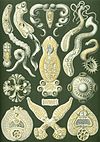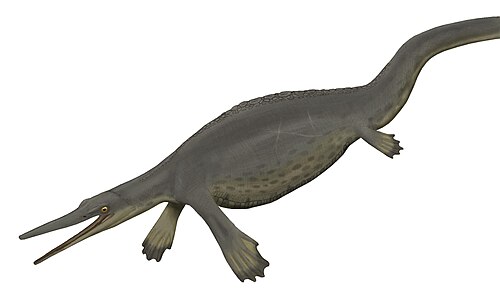User:Abyssal/Portal:Triassic
IntroductionThe Triassic (/traɪˈæsɪk/ try-ASS-ik; sometimes symbolized 🝈) is a geologic period and system which spans 50.5 million years from the end of the Permian Period 251.902 million years ago (Mya), to the beginning of the Jurassic Period 201.4 Mya. The Triassic is the first and shortest period of the Mesozoic Era. Both the start and end of the period are marked by major extinction events. The Triassic Period is subdivided into three epochs: Early Triassic, Middle Triassic and Late Triassic. The Triassic began in the wake of the Permian–Triassic extinction event, which left the Earth's biosphere impoverished; it was well into the middle of the Triassic before life recovered its former diversity. Three categories of organisms can be distinguished in the Triassic record: survivors from the extinction event, new groups that flourished briefly, and other new groups that went on to dominate the Mesozoic Era. Reptiles, especially archosaurs, were the chief terrestrial vertebrates during this time. A specialized subgroup of archosaurs, called dinosaurs, first appeared in the Late Triassic but did not become dominant until the succeeding Jurassic Period. Archosaurs that became dominant in this period were primarily pseudosuchians, relatives and ancestors of modern crocodilians, while some archosaurs specialized in flight, the first time among vertebrates, becoming the pterosaurs. Therapsids, the dominant vertebrates of the preceding Permian period, declined throughout the period. The first true mammals, themselves a specialized subgroup of therapsids, also evolved during this period. The vast supercontinent of Pangaea dominated the globe during the Triassic, but in the following Jurassic period it began to gradually rift into two separate landmasses, Laurasia to the north and Gondwana to the south. The global climate during the Triassic was mostly hot and dry, with deserts spanning much of Pangaea's interior. However, the climate shifted and became more humid as Pangaea began to drift apart. The end of the period was marked by yet another major mass extinction, the Triassic–Jurassic extinction event, that wiped out many groups, including most pseudosuchians, and allowed dinosaurs to assume dominance in the Jurassic. (Full article...) Selected article on the Triassic world and its legacies
The flatworms, or Platyhelminthes are a phylum of relatively simple bilaterian, unsegmented, soft-bodied invertebrates. Unlike other bilaterians, they are acoelomates, (having no body cavity), and no specialized circulatory and respiratory organs, which restricts them to having flattened shapes that allow oxygen and nutrients to pass through their bodies by diffusion. The digestive cavity has only one opening for both the ingestion (intake of nutrients) and egestion (removal of undigested wastes); as a result, the food cannot be processed continuously. Over half of all known flatworm species are parasitic. Free-living flatworms are mostly predators, and live in water or in shaded, humid terrestrial environments such as leaf litter.
Analyses since the mid-1980s have separated out one subgroup, the Acoelomorpha, as basal bilaterians (animals with bilateral symmetry and hence with distinct front and rear ends). The remaining Platyhelminthes form a monophyletic group - one that contains all and only descendants of a common ancestor that is itself a member of the group. The redefined Platyhelminthes is part of the Lophotrochozoa, one of the three main groups of more complex bilaterians. These analyses had concluded the redefined Platyhelminthes, excluding Acoelomorpha, consists of two monophyletic subgroups, Catenulida and Rhabditida, with Cestoda, Trematoda and Monogenea forming a monophyletic subgroup within one branch of the Rhabditophora. Hence, the traditional platyhelminth subgroup "Turbellaria" is now regarded as paraphyletic, since it excludes the wholly parasitic groups, although these are descended from one group of "turbellarians". (see more...) Did you know?
Need help?Do you have a question about Abyssal/Portal:Triassic that you can't find the answer to? Consider asking it at the Wikipedia reference desk. Selected image
Selected article on the Triassic in human science, culture and economicsThe Bone Wars is the name given to a period of intense fossil speculation and discovery during the Gilded Age of American history, marked by a heated rivalry between Edward Drinker Cope and Othniel Charles Marsh. The two paleontologists used underhanded methods to out-compete the other in the field, resorting to bribery, theft, and destruction of bones. The scientists also attacked each other in scientific publications, attempting to ruin the other's credibility and cut off his funding. Originally colleagues who were civil to each other, Cope and Marsh became bitter enemies after several personal slights between them. Their pursuit of bones led them west to rich bone beds in Colorado, Nebraska, and Wyoming. From 1877 to 1892, both paleontologists used their wealth and influence to finance their own expeditions and to procure services and fossils from dinosaur hunters. By the end of the Bone Wars, both men exhausted their funds in fueling their intense rivalry. Cope and Marsh were financially and socially ruined by their efforts to disgrace each other, but their contributions to science and the field of paleontology were massive; the scientists left behind tons of unopened boxes of fossils on their deaths. The feud between the two men led to over 142 new species of dinosaurs being discovered and described. Several historical books and fictional adaptations have also been published about this period of intense paleontological activity. (see more...) GeochronologyEpochs - Early Triassic - Middle Triassic - Late Triassic Landmasses - Baltica - Gondwana - Laurentia - Siberia Fossil sites - Beecher's Trilobite Bed - Walcott–Rust quarry Researchers - Charles Emerson Beecher - Charles Lapworth - Charles Doolittle Walcott Quality ContentFeatured Mesozoic articles - Bone Sharps, Cowboys, and Thunder Lizards - Bone Wars - Edward Drinker Cope - Geology of the Capitol Reef area - Geology of the Death Valley area -Geology of the Grand Canyon area - Geology of the Zion and Kolob canyons area Good Mesozoic articles - Chitinozoan - Coal ball - Dimetrodon - History of paleontology - Evolutionary history of life - Ornatifilum - Opabinia - Paleontology- Schinderhannes - Small shelly fauna - Temnospondyli - Tiktaalik - Waptia SubcategoriesRelated contentAssociated WikimediaThe following Wikimedia Foundation sister projects provide more on this subject:
|




















